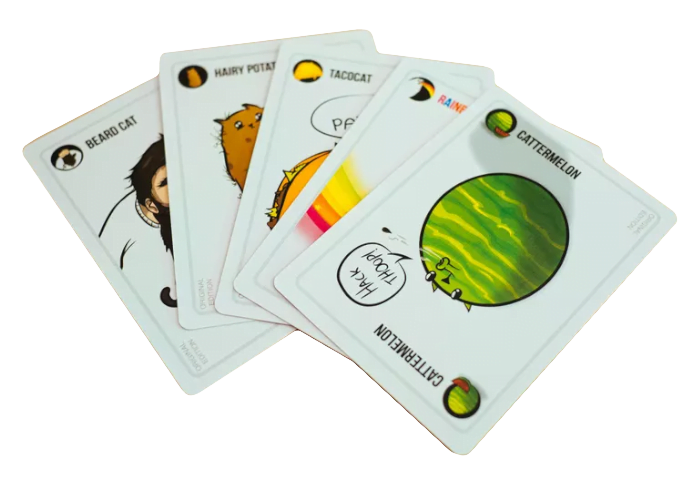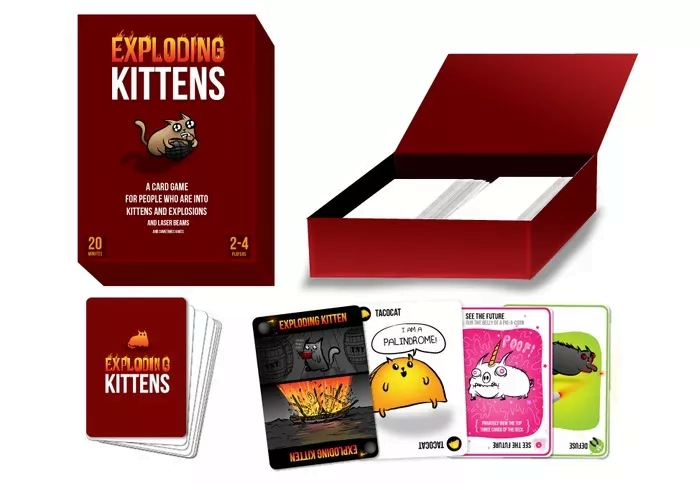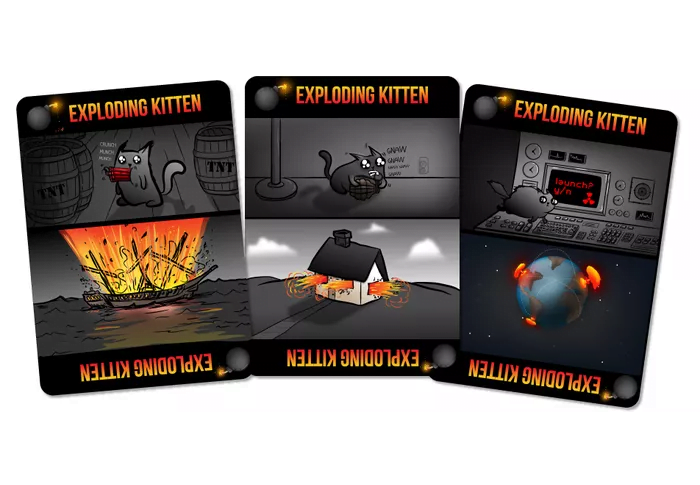It’s easy to criticise extremely successful products. I know, I do it all the time because almost all the products I look at are the byproduct of some form of success, otherwise I wouldn’t know about them. I’m not some underground game developer showing up to the weirdest backroom board game conventions and seeing the dankest designs that everyone in the scene is buzzing about. I consume the mainstream slop everyone is seeing thanks to the same general apertures of distribution, and the only thing that differentiates that is that I can’t get a bunch of things that are unavailable because of international shipping rates. It is just the way of these things.
I still feel a bit cautious about talking smack about Exploding Kittens because it’s a fantastically successful kickstarter game made by an internet creator. It’s indie enough that I feel like there’s a chance someone involved may see this and it’s successful enough that it should absolutely feel like I’m being all sour grapes over a game I see as ‘undeserving’ of its immense, immense success.
Bonafides then; I don’t much like Exploding Kittens. I never backed it, I played it once at a convention and then I decided I didn’t like it and didn’t want a copy and then never touched anything from the same space ever again. Despite this, I don’t think it’s a ‘bad game’ or somehow diminishes a collection or shouldn’t succeed or doesn’t deserve its success. It’s a monetised thing from a monetising creator, and it’s not like you go into Exploding Kittens without being very, very aware of its sense of humour and style. It’s right there, on the box.
Exploding Kittens is a card game where players are drawing cards from the deck, hoping to avoid a card that says ‘you lose the game.’ When they draw that card, they have to reveal it to the table and lose the game. You can prevent this by using, instead, a ‘defuse’ card that puts that card back into the deck wherever you want to put it, and you can keep that information secret from the rest of the players. Everyone starts with a defuse card in hand, and the rest of the cards in the deck either let you steal cards from another player, skip the draw on your turn, force other players to draw more, inspect the deck, shuffle the deck, or counter another player’s cards. That’s pretty much the whole game, those eight pieces, and the rest of differentation is just art. The play pattern is consistent, the mechanics are learnable and the whole game is both short enough to iterate on and engaging enough to keep people from just blowing through it and feeling like they were screwed.
It is a perfectly solid unit of gameness and its quality as a game is absolutely unrelated to whether or not I like it. Now, setting aside whether or not it’s a good game or I like it or if I have a problem with it, let’s talk about the persistent, nagging feeling I have under my fingertips when I remember shuffling that game up and the way the cards are designed.

See, I didn’t want to play this game so I didn’t. But when I started teaching classes, it was a great game to get students to play because it teaches some useful lessons, it’s reasonably approachable, and it has a story they can get a hold of. In fact, it’s so useful, two months ago I ran something like thirty games of it in three days to get a whole bunch of people who never played card games before into the mindspace of kickstarter and niche board games. Shuffling up deck after deck because I’m faster at shuffling than the players of these games meant I looked at them a lot, and it’s hard to engage with any game that much without forming opinions on it.
Look, okay, so, here. Here’s the complaint: Why isn’t the card-back symmetrical?
There are problems you can have in a game that you address through player rules. There are problems you can have in a game that you address through incentives. There are problems you can have in a game that you address through the very structure of the pieces themselves. In Chess none of the pieces are so big they ambiguate where they stand on the board. In Yahtzee, your dice roles are public so nobody is going to have an opportunity to cheat on what they rolled. In Cluedo, the cards that you’re looking for are removed from the pool of cards, so you have to determine them from excluded information.
In Exploding Kittens, there is an information leak in the game that would be so easy to address.
Now look, a big part of why people like this game – I assume – is the art. They like The Oatmeal and they want some more of that oating and mealing on their cards. The way this artist draws bumcracks and eyes pointing in different directions is just part of what makes this whole experience fun for them and I don’t want to take that away. You’re doing set collection for a quantity of the cards, where there’s a lot of cards in the deck that don’t do anything, but with an identical other card, they can swipe a card from someone else, which has this nice way of reducing the total pool of cards while also serving to clog up hands and prevent an overwhelming advantage to card draw.
But the thing is, as these cards are designed, there is a correct orientation for all of them. The art occupies the bulk of the card face, with a lot of white area around them, and the rules text is a small space down the bottom. This means that to read all these cards, you need to orient them in one particular way, and cards come out of the deck into your hand to be arranged.
A part of this game is a card being inserted into that deck of cards from a player’s hand. That is to say, there is a time in which the players can orient the card and insert it into the deck incorrectly, because of how they are oriented to that deck. And you can argue, hey, well, all the cards will be mixed up and boxed because of the natural play pattern, so it doesn’t matter, except, the thing is, that’s only true if you have a symmetrical arrangement for the playing of the game.
If the back of the cards was symmetrical – if it didn’t have a correct orientation – you just avoid this problem. And you might think ‘well, it’s not much of a problem’, but… it’s a problem you don’t need to have. And I know graphic design is important to this game. It’s kind of one of its major selling points. I can understand not wanting to make the card art on the faces symmetrical. But you could make the rules text symmetrical. Flip it and stick it up on the top as well as on the bottom, so players don’t need to rummage around in their hand to play the game. Putting the text at the top of the card rather than the bottom also means that the cards can be fanned more readily and players can read their hand at a glance, and therefore aren’t as reliant on memory, but we’ll call that ‘advanced strats’ for user interface.
I think you can make games. I think you can take whatever idea you have for making a game and make it. And then, best of all, I think you can take your idea and expand on it and make it great. Part of making it great is understanding why things work the way they do in other games, and making choices that match your own wants.
Exploding Kittens isn’t a bad game, but it could be, very easily, polished a little more, and made a little better.

